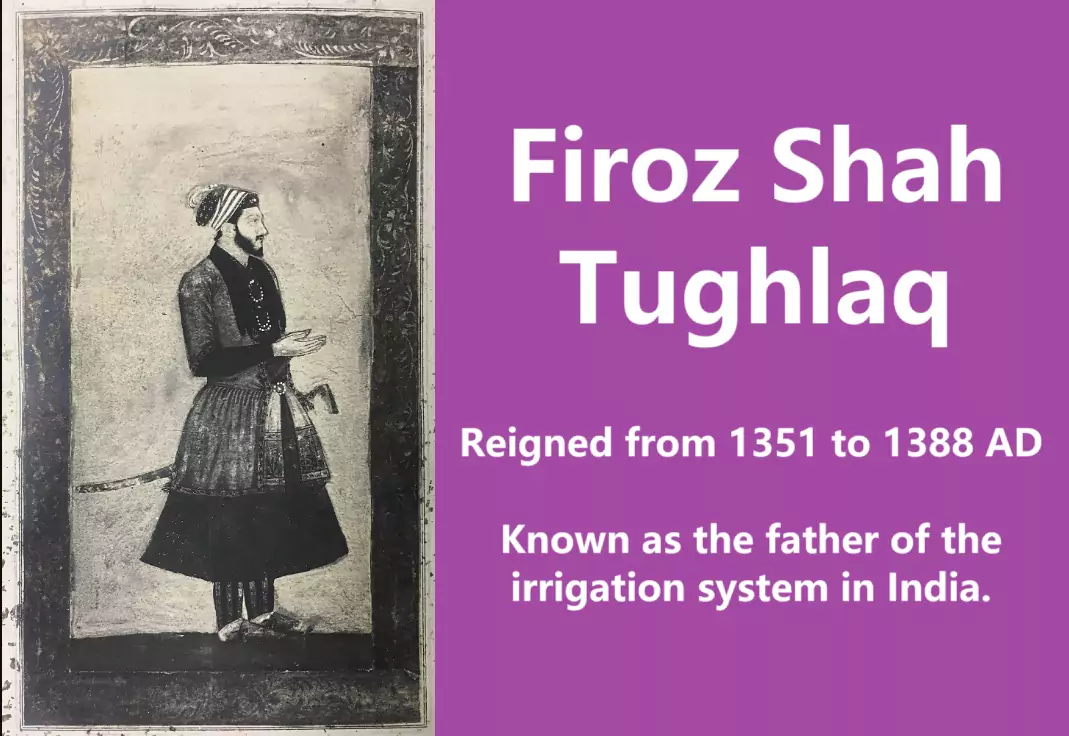Firoz Shah Tughlaq was the third important ruler of the Tughlaq Dynasty. He ruled the Delhi sultanate for a long time, approximately 37 years. He became the king in 1351 after his uncle Muhammad bin Tughlaq died in Thatta. This article provides important key points and NCERT notes from Firoz Shah Tughluq. These key points are important as GK for UPSC prelims and other competitive government job examinations.
Background
- Firoz Shah Tughluq’s father was Rajab Tughlaq or Malik Rajab (brother of Ghiyasuddin).
- His mother was Niladevi (a Hindu woman). She was the daughter of Rajamal from Dipalpur.
- 1309: He was born in Jaunpur (now in Pakistan).
- 1351: He succeeded his cousin Muhammad bin Tughlaq and became Sultan of Delhi.
- He ascended the throne at the age of 42.
- His reign was from 1352 to 1388.
- He learned the Arabic and Persian languages.
- Firoz Shah Tughluq also acquired military skills as a young boy.
Info: Firoz Shah Tughluq got the title of “emir” (high rank of military commander) when he served under Muhammad bin Tughluq.
He introduced the idea of pious monarchy. He gained the allegiance of the Caliphs. He declared himself a ‘servant of the Caliph’.
Info: Kutub was a physics book written by Firoz Shah Tughlaq

Various Reforms of Firoz Shah Tughlaq
Revenue Reforms:
- He abolished 24 types of taxes in his empire as not prescribed by Sharia.
- Apart from this, he introduced some new taxes. These were – Kharaj, Khams, Jizya Zakat and irrigation.
- Jizya was a religious tax imposed on Hindus.
- Zakat as a religious tax was introduced for Muslims.
- Khawaja Hisamuddin (inspector) conducted a revenue survey to determine taxes.
- He collected revenue estimated at 6,75,00,000 Tanka.
- He started the endowment of jagirs instead of salaries to troops and servants and made them hereditary.
- He is called the ‘Akbar of the Sultanate’.
- He introduced three low-denomination coins-
- ‘Jital’
- Half-Jital or ‘Adha’
- ‘Sikki Jital‘ or ‘Bikh’.
Tax structure:
- Kharaj: a land tax equivalent to 10% of the grain produced on the land.
- Zakat: A tax of 2.5 percent on goods acquired by Muslims.
- Kham: took twenty percent of the loot (eighty percent went to the warriors).
- Jaziya: Imposed on non-Muslims, especially Hindus. (Not applied for women and children)
Irrigation System Reforms:
- Feroze Shah Tughlaq constructed 5 new canals and renovated many old canals.
- Haqq-i-Sharab a kind of water tax was imposed on the farmers using canal water.
- The extent of the new canals constructed by him was —
- Yamuna river to Hisar (150 miles),
- Shatabu to Gharghara (96 miles),
- Sirmur Valley to Hansi,
- Gharghara to Firozabad,
- Yamuna to Firozabad.
Info: Yamuna to the Sutlej Canal supported his newly built city of Hissar-i-Firoza.
Administrative Reforms
- He had about 140 thousand slaves in his empire. He established a department for slaves called ‘Dewan-i-Bandegaan’.
- He also opened an employment office for the unemployed.
- Established a charitable hospital called Dar-ul-Safa for the welfare of common people.
- Firoz Shah Tughlaq established a department called ‘ Dewan-e-Khayrat’ for the relief of Muslim poor, orphans, widows
- He also created another department called ‘Dewan-e-Istihaq’ for financial assistance to deserving scholars.
- He built the cities of Jaunpur, Firozabad, Fatehabad, Hisar and Firozpur.
- 1358: He founded the new city of Firozabad near Delhi.
- 1360: He established Hisar city in the northern part.
- 1366: He established a new city called Jaunpur in eastern Uttar Pradesh.
- 1367: He constructed Fatehabad city in Haryana.
- 1375: Firoz Shah Tughlaq repaired and restored Qutub Minar damaged by an earthquake.
- Apart from these, he also built a total of 36 factories and many gardens, dams, mosques, lodges, and reservoirs.
- Firoz Shah abolished the pre-introduced Dag and Hulia systems.
- He built many rest houses called Sarai, gardens and tombs in the Delhi region.
Info: Diwan-i-arz was the Department of military affairs established by Firuz Shah.
Info: Firoz Shah Tughlaq divided his kingdom into 24 provinces. Each province was called sir-i-koh. All the sir-i-koh were divided into 49 districts.
Religious Policy
- Firoz Shah Tughlaq was an orthodox ruler. He gave high status to Ulemas. Ulemas helped him to make major decisions.
- He was a follower of Sunni Islam (Hanafi).
- He promoted Islam by appointing Jagirs throughout the country.
- He imposed the Jazia tax on Brahmins and rich Hindus.
- He sometimes burned alive the Brahmins.
- He demolished many small Hindu temples by following Shariyat.
Kingdom conquested
Feroze Shah Tughlaq was not particularly successful as a warrior. Some of the important campaigns of his reign are-
| Year | Region | Key Points |
|---|---|---|
| 1353 | Bengal | He failed in this battle during the time of Ilyas Shah. |
| 1354 | Sindh | He successfully captured the Sindh province. |
| 1356-1357 | Malwa | Malwa was annexed to the Delhi Sultanate. |
| 1359 | Bengal | A treaty was made with Sikandar Shah and Feroze Shah accepted the independence of Bengal. |
| 1359-1360 | Jajnagar (Orissa) | At that time the king of Orissa was Bhanudeva III. Sultan destroyed the Jagannath temple in Puri. |
| 1361 | Nagarkot | The King of Nagarkot submitted. Azizuddin Khan destroyed the Jalamukhi temple and collected 1300 Sanskrit idols and translated them into Persian. |
| 1362-1363 | Gujarat and Sindh | He suppressed the rebellions from Gujarat and Sindh. |